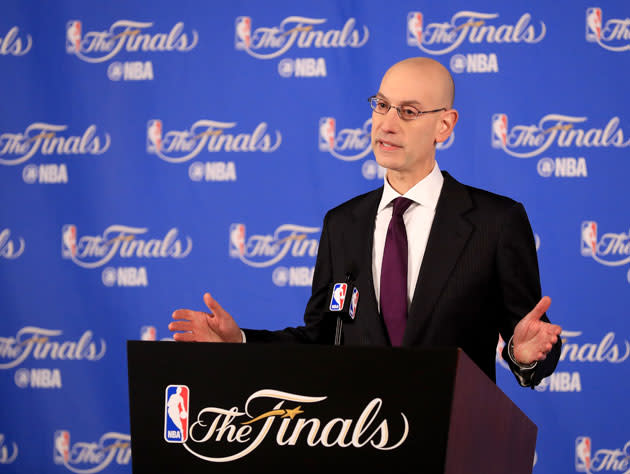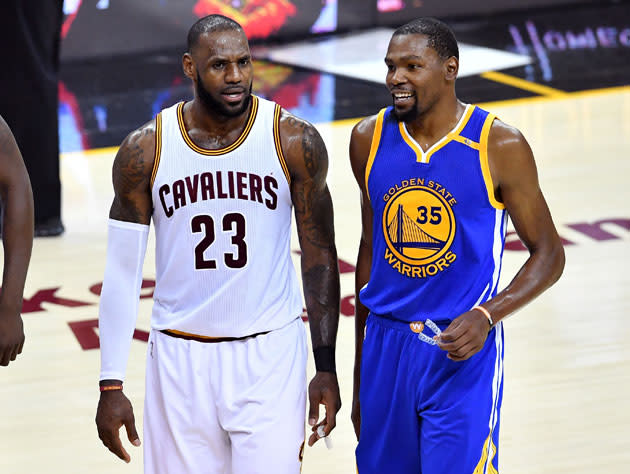Adam Silver drafts guidelines penalizing teams resting 'multiple starters on the same night'

The NBA is ready to further outline its expectations for what constitutes appropriate rest, as the league looks to find a way to legally outlaw the sort of embarrassing bouts of star absences that seemed to bedraggle its best-known players on the date of what should have been some of the NBA’s showcase games. Boffo contests involving the league’s two NBA Finalists from Cleveland and Golden State, along with numerous other top-line national franchises, were cut off at the broadcast knees by a coach’s decision to rest stars amid what could become a 100-game season.
[Fantasy Football is open! Sign up now]
Of course, the Cleveland Cavaliers (despite some notable sit-outs) did not get to the NBA Finals for the third consecutive year in 2017 by resting its stars: LeBron James led the NBA in minutes at age 32. Golden State’s Warriors merely had to stay free from freak accidents involving Kevin Durant, establishing rhythm in what turned out to be a much-needed regular season practice bout, before its 15-1 (and counting) postseason.
The rest didn’t help the Spurs, it didn’t help the Clippers, the Cavs appeared to lose their nerve in limiting LeBron and the Warriors’ great enemy seemed to be unfamiliarity and indecision by way of inexperience with Durant, as opposed to tired legs. If anything, it was the toaster that led the Warriors onward.
Those unintended outcomes won’t take away from the initial outrage, and the clamor that persists. The league has an embarrassment on its hands when it comes to the issue of player rest, with no clear solution that wouldn’t involve the reduction of the league’s 82-game regular season, a standard that still has a chance to outlive all of us.
As, seemingly, will talk about how to handle dragging stars through 100-plus-game campaigns dotted with nearly nightly expectations of appointment viewing. NBA commissioner Adam Silver was recently asked by ESPN’s Marc Stein on his podcast if the league was ready to get heavy-handed with its policy, presuming that it could between bouts of collective bargaining with the players union:
“We’re not ready to go there yet,” said Silver. “We had a conference call with the competition committee earlier today, and as I had said the other day, where we’re heading is the adoption of a set of guidelines that will be in place for next season which will strongly recommend that the extent players are rested, they’re rested at home and not rest multiple starters on the same night.”
You likely weren’t finished with the entirety of Silver’s quotes (transcription via RealGM) before discovering some workarounds, as teams trade off games played both at home and on the road.
This means fans in Memphis won’t see Rockets from Houston on a Saturday, after the Rockets played at home on Friday. It means paid attendees in Miami and Orlando might have to wonder which night they’ll be allowed to see Blake Griffin, and which night they’d be blessed with the image of a suited-up Chris Paul. The Clippers can’t “rest multiple starters on the same night,” after all.
“I’m reluctant to get into the business of directing these great coaches on minutes because players are often injured during the season but not to the point where they otherwise can play but maybe shouldn’t play but it’s a function of league doctors versus team doctors on how healthy a player is and whether it’s appropriate the player be out on the floor on that night.
“I would like to come up with a system that relies on the good faith of our teams that the extent rest is necessary and it’s done in an appropriate way.”
[Follow Ball Don’t Lie on social media: Twitter | Instagram | Facebook | Tumblr]
Silver isn’t ready to fully litigate because, frankly, he has little to work with at this point beyond acting in the spirit of ever-evolving and eternally nebulous ideas regarding “what’s best” for the NBA from year to year.
The league would have to work arm-in-arm with the NBPA between collective bargaining discussions, a borderline-emergency session that either side would be less interested in discussing during a summer than, say, the influx of hundreds of millions of dollars of television money, and whether or not we’re allowed to spend it all at once.
The league and its players know that the best way around tired players is to do away with what established tired players in the first place – the NBA’s bananas 82-game schedule, created for glorified tent show hucksters and Hockey Guys to fill their ratty barns with in a postwar boom thought to have enough thirst for, apparently, 82 games’ worth of professional basketball per year.
That wouldn’t be the case for another three decades, but not before heaps of nationally-known NBA books detailed the too-long season, and the impossible task of treating sometimes-enervating professional basketball contests as if they were, I dunno, a baseball game or something.
The task is far less arduous in 2017, but the season is still too lengthy by a long stretch, and consideration in cutting wasn’t even discussed by Silver or Stein in their back and forth. Even if the option were on the table, such an explanation would have taken up an entire, hour-long podcast (this one, in a busy week for Silver, went ten minutes).

For now, Silver can explain away. With just a short list of caveat-rich data, drawing a line between mid-season rest and postseason excellence remains a real stretch.
The way players jump around, Kevin Durant’s old minutes restriction in Oklahoma City and Miami’s move to sit Dwyane Wade for heaps of regular season games years ago may have made millions for the Warriors and Bulls (who snuck into the playoffs partially on Wade’s back, late-season) franchises this season. Warrior fans wary of the team’s free agent treatment of Andre Iguodala will have to consider Dre’s time with Tony DiLeo in Philadelphia, at nearly 40 minutes a game, and you’re no fun if you remind a Cavs fan that 36-year old Kyle Korver spent two years practicing under Tom Thibodeau.
This is a small family, with disparate interests – Boston sitting Isaiah Thomas in a road game in Phoenix next season might not be appreciated by a Suns team minding its lottery odds. The great bulk of NBA team income is already assured, attendance won’t be swayed too much by the threat of star sitting, and NBA team front offices have long had ways of packaging less-desirable games with other enticements to slide your debit card.
For now, the NBA can only work around the fringes with Silver’s drawn-up group of guidelines, and hope that clubs easily fake-limping their way around the enhanced rules aren’t brazen with their slick disobedience, and that coaches don’t fight too literally when it comes to excusing players that truly, genuinely, do have knee tendinitis.
It’s only that 82-game expectation, and our assigned values, that turns an actual case of knee tendinitis into “knee tendinitis,” a go-to bug designed to sit the team’s highest-paid, highest-jumping, player. As if inflamed knees are something you should be playing NBA games on.
As the league piles more rules on, enforceability yet to be determined, it will once again rely on the next-best idea to make the rest issue a resolved one.
The NBA will have a longer calendar season in 2017-18, keeping the 82 games but starting the campaign earlier in October to move closer toward eliminating back-to-back contests, and deadening stretches of tightly-packed games. As we gather the data, the NBA will have bought itself a few years. Outlining rest expectations will only drive the conversation further away from the 82-game discussion, which is good news for both Paul George and popcorn vendor.
Distinct guidelines only settle so much, while the quality of airfare and lodging and expertise of a franchise’s million-buck medical staff only goes so far when it comes to preventing a player from tugging at his shorts – 82 games are a lot of games.
Especially for the sort of stars who sit out games. The sort of guys that play way more than 82 games, most seasons.
– – – – – – –
Kelly Dwyer is an editor for Ball Don’t Lie on Yahoo Sports. Have a tip? Email him at KDonhoops@yahoo.com or follow him on Twitter!


